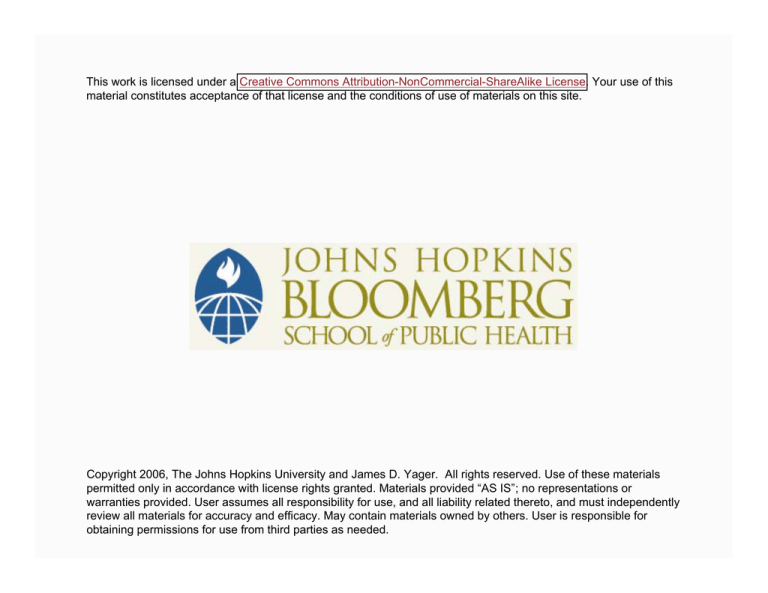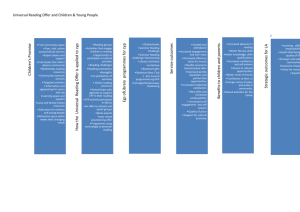
This work is licensed under a Creative Commons Attribution-NonCommercial-ShareAlike License. Your use of this
material constitutes acceptance of that license and the conditions of use of materials on this site.
Copyright 2006, The Johns Hopkins University and James D. Yager. All rights reserved. Use of these materials
permitted only in accordance with license rights granted. Materials provided “AS IS”; no representations or
warranties provided. User assumes all responsibility for use, and all liability related thereto, and must independently
review all materials for accuracy and efficacy. May contain materials owned by others. User is responsible for
obtaining permissions for use from third parties as needed.
Genetic and Environmental Factors As
Determinants of Susceptibility to Disease
Initiated during Development
James D. Yager, PhD
Johns Hopkins University
Lecture Outline
General principles of toxicology and of developmental
toxicology
Effects of exposure to diethylstilbestrol during
pregnancy
Cytochrome P450 biotransformation enzymes
General function
CYP 2E1
Function in alcohol metabolism
Genetic polymorphisms
Changes in expression during development
Genetic, environmental life-style factors and risk
3
Section A
General Principles of Toxicology and of
Developmental Toxicology
The Toxicological Paradigm
Toxicokinetics
Toxicodynamics
Exposure
Internal
Dose
Biologically Effective
Dose
Early Biological
Effect
Altered
Structure/Function
Disease
Susceptibility Factors
Exposure Assessment
Risk Assessment
5
Toxicological Process in Vivo
Adapted from: Frazier. (1990) In Vitro Toxicology, 3, 349–357.
6
Developmental Toxicology
A birth defect is "any anomaly, functional or
structural, that presents in infancy or later in life and
is caused by events preceding birth, whether
inherited, or acquired.”
March of Dimes
7
Factors That Affect Pregnancy and Infant Health
Social Factors
Behavior, community, medical care
Pregnancy
& Infant
Health
Biological Factors
Genetics, gender, age
Source: March of Dimes
Birth Defects &
Developmental
Disorders
Environmental Factors
Diet, tobacco, chemicals, radiation
8
Selected Categories of Preventable Birth Defects
Birth defects
Estimated incidence
Prevention measure
I. Structural/metabol i c
Neural tube defect s
1 in 1,600 births
Folic acid
II. Congenital infecti o n s
Congenital syphilis
1 in 2,000 births
Safe sex prior to conception/
treatment
Congenital HIV
1 in 2,700 births
Safe sex prior to conception/
avoid risks
Congenital rubella syndr o m e
1 in 100,000 births
Immunization
III. Other
Rh disease
1 in 1,400 births
Immunoglobi n
Fetal alcohol syndrome
1 in 1,000 births
Avoid alcohol
Note: All numbers are based on the best available estimates, which underestimate the incidence of many birth defects.
Source: March of Dimes, Metropolitan Atlanta Congenital Defects Program and California Birth Defects Monitoring Program
9
Causes of Birth Defects
Maternal
infection 2%
Drugs, chemicals,
and radiation 2%
Maternal metabolic
factors 1%
Birth trauma and
uterine factors 1%
Cytogenetic
disease 4%
Hereditary
disease
20%
Unknown
causes 70%
10
Effects of Alcohol on Pregnancy
Fetal Alcohol Spectrum Disorder (FASD)
Miscarriage
Preterm birth
Low birth weight
FAS
ARBD
alcohol-related birth defects
ARND
alcohol-related neurodevelopmental disorders
Birth complications
11
Principles of Developmental Toxicity: Toxic Windows
12
Critical Periods of Human Development
Critical Periods of Human
Development for Teratogen Sensitivity
Source: Jones RE. Human Reproductive Biology. Academic Press, Inc. New York (1991)
13
Principles of Developmental Toxicity: Toxic Window
Expected incidence of malformation of different organs and systems,
the susceptibility of which varies according to the days of gestation
14
Human Developmental Intoxicants
Radiation
Infections
Rubella virus
Cytomegalovirus
Herpes virus hominis
Toxoplasmoisis
Syphilis
Maternal metabolic imbalances
Alcoholism
Cretinism
Diabetes
Folic acid deficiency
Hyperthermia
Phenylketonuria
Rheumatic disease
Drugs and chemicals
Androgenic chemicals
Antibiotics
Anticancer drugs
Anticonvulsants
Diphenylhydantoin,
trimethadione
Antithyroid drugs
Chelators
Penicillamine
Chlorobiphenyls
Cigarette smoke
Cocaine
Coumarin anticogulants
Diethylstilbesterol
Ethanol
Ethylene oxide
Iodides
Lithium
Metals
(Mercury(organic)
Lead
Retinoids
Thalidomide
15
Section B
Effects of Exposure to Diethylstilbestrol
during Pregnancy
Estrogens
OH
HO
OH
HO
Estradiol
Diethylstilbestrol
17
Diethylstilbestrol (DES)
Given to about 4.8 million pregnant women to
prevent miscarriage
Effects of in utero exposure on human female
progeny
Vaginal cancer in young women
(1.4/1,000–10,000)
Reproductive problems (18%)
Effects of in utero exposure on human male
progeny (3 times normal incidence)
Anatomic abnormalities of the reproductive
tract
Altered semen—including decreased sperm
density, count, and motility
18
Estrogen concentration
Critical Period for Exposure to DES
Human
Critical period
1
2
Pregnancy (trimester)
3
19
How Does DES Work?
DES is a potent estrogen
20
Mechanisms of Estrogen Receptor–Mediated Effects
Estrogens
DNA strand
Estrogen receptors
mRNAs
Specific P450s
Oxidative metabolites
Nucleus
Specific proteins
Mitochondria
21
DES Is Also Metabolized
HO
O
OH
O
P450-mediated
Diethylstilbestrol
DES Quinone very reactive
Species differences
Tissue differences
22
Estradiol Is Also Metabolized
18
18
12
13
C
1
2
HO
3
14
10
15
HO
7
3
P450s
18
Estradiol
12
10
2
O
3
9
6
O
15
6
Estradiol Catechol
8
14
D
16
15
7
5
Source: Adapted from Zhu and Conney. (1998) Carcinogenesis.
16
OH
CH3
13
C
B
A
D
17
11
1
8
14
7
5
OH
6
13
9
B
A
OH
CH3
17
C
1
16
2
8
5
4
12
11
D
9
B
A
CH3
17
11
10
OH
Estradiol Quinone
23
Environmental Chemicals with Hormone Activity
OH
OH
OH
O
HO
O
HO
Genistein
Estradiol
O
Cl
H
C
Cl
CCL3
HO
Equilenin
o,p-DDT
Continued
24
Environmental Chemicals with Hormone Activity
OH
OH
OH
O
HO
O
HO
Genistein
Estradiol
O
Cl
H
C
Cl
CCL3
HO
Equilenin
o,p-DDT
25
Section C
Cytochrome P450 Biotransformation
Enzymes: General Function and CYP 2E1 in Alcohol
Metabolism
Cytochrome P450 (CYP) Enzymes
Phase I biotransformation of xenobiotics
(environmental chemicals) and endogenous
molecules
Functions of CYPs
Add or expose functional groups
27
Biotransformation of Xenobiotics
P 450s
Tissue
Accumulation
No
Biotransformation
Phase I
Product
Expose/Add
Functional
Groups
Elimination
Xenobiotic
Elimination
Conjugation
Phase II
Product
28
Biotransformation Reactions
Biotransformation reactions: exposing a functional
group
OCH3
OCH2OH
OH
+ HCHO
NO2
p- Nitroanisole
NO2
NO2
p- Nitrophenol
Continued
29
Biotransformation Reactions
Biotransformation reactions: adding a functional
group
Sulfate conjugation
Functional group introduced
OSO3H
Phenyl sulfate
OH
O
Benzene
Glucuronic acid
Phenol
Glucuronide conjugation
Phenyl glucuronide
30
Multiple Forms of P450
Major Mammalian Cytochrome P450 Gene Families
P450 GENE
SUBFAMILY
IA
IIA
IIB
IIC
IID
IIE
IIIA
CHARACTERISTIC
INDUCER
Polycyclic aromatic
hydrocarbons
Phenobarbital
Ethanol
Steroids
CHARACTERISTIC
REACTION
Benzo(a)pyrene hydroxylation
Steroid hydroxylation
Benzphetamine demythelation
Steroid hydroxylation
Debrisoquine hydroxylation
Ethanol hydroxylation
Steroid hydroxylation
31
Functions of CYP 2E1
Metabolism of ethanol
Metabolism of certain drugs and environmental
chemicals
Drugs
Acetaminophen
Chlorzoxazone
Environmental chemicals
Chloroform
Benzene
Toluene
Inducible
32
Metabolism of Ethanol
Alcohol dehydrogenase
Ethanol
Acetaldehyde
Acetaldehyde dehydrogenase
Acetate
CYP 2E1
Reactive oxygen species
Damage to proteins
Damage to mitochondria
Reactive oxygen species
33
Section D
Cytochrome P450 Genetic Polymorphisms:
Changes in Expression during Development
CYP 2E1 Gene Structure
Lee et al. (1996). J Biol Chem, 12063–12067.
35
Cytochrome P450 2E1
Genetic polymorphism that affects expression
Changes in expression during embryonic/fetal
development
36
Human CYP 2E1 Polymorphism
Use of restriction endonucleases and Southern
blots to detect polymorphism
Detection of 100 bp insertion in regulatory region of
P450 2E1 gene
Determination of functional effect of the
polymorphism
Metabolism of chlorzoxazone metabolism to 6hydroxychlorzoxazone in human subjects
37
Restriction Endonucleases
XbaI
#ER0681
1500u
5'-T^C T A G A-3'
3'-A G A T C^T-5
DraI (AhaIII)
#ER0221
1500u
5'-T T T^ A A A-3'
3'-A A A^T T T-5'
38
Polymorphism in the Upstream Region of CYP 2E1
Source: McCarver D. G., Byun R., Hines R. N., et al. (1998) A genetic polymorphism in the regulatory sequences of human CYP2E1: association
with increased chlorzoxazone hydroxylation in the presence of obesity and ethanol intake, Toxicol Appl Pharmacol, 152, 276–281.
39
Polymorphism in the Upstream Region of CYP 2E1
Source: McCarver D. G., Byun R., Hines R. N., et al. (1998) A genetic polymorphism in the regulatory sequences of human CYP2E1: association
with increased chlorzoxazone hydroxylation in the presence of obesity and ethanol intake, Toxicol Appl Pharmacol, 152, 276–281.
40
Chlorzoxazone Metabolism
Administered 500 mg
Took blood sample three hours later
41
Chlorzoxazone Hydroxylation Index
Polymorphism vs. CYP 2E1 Metabolic Ability
Source: McCarver D. G., Byun R., Hines R. N., et al. (1998) A genetic polymorphism in the regulatory sequences of human CYP2E1: association
with increased chlorzoxazone hydroxylation in the presence of obesity and ethanol intake, Toxicol Appl Pharmacol, 152, 276–281.
42
CYP 2E1 Expression vs. Age
Source: Johnsurd E. K., Koukouritaki S. B., Divakaran K., et al. (2003). Human hepatic CYP2E1
expression during development. J Pharmacol Exp Ther, 307, 402–407.
43
CYP 2E1 Expression: First Six Postnatal Months
Source: Johnsurd E. K., Koukouritaki S. B., Divakaran K., et al. (2003). Human hepatic CYP2E1
expression during development. J Pharmacol Exp Ther, 307, 402–407.
44
Changes in Expression during Development
Summary of CYP 2E1 Changes in Expression During Development
Source: Johnsurd E. K., Koukouritaki S. B., Divakaran K., et al. (2003). Human hepatic CYP2E1
expression during development. J Pharmacol Exp Ther, 307, 402–407.
45
Electrophoretic Determination
CYP 2E1 *1C and *1D genotypes—electrophoretic
determination
Source: Johnsurd E. K., Koukouritaki S. B., Divakaran K., et al. (2003). Human hepatic CYP2E1
expression during development. J Pharmacol Exp Ther, 307, 402–407.
46
CYP 2E1 Genotype vs. Expression during Development
Source: Johnsurd E. K., Koukouritaki S. B., Divakaran K., et al. (2003). Human hepatic CYP2E1
expression during development. J Pharmacol Exp Ther, 307, 402–407.
47
Genetic, Environmental, and Life-Style Factors and Risk
Genetic & Environmental/Life-Style
Susceptibility Factors
RISK
Genetic & Environmental/Life-Style
Protective Factors
48







